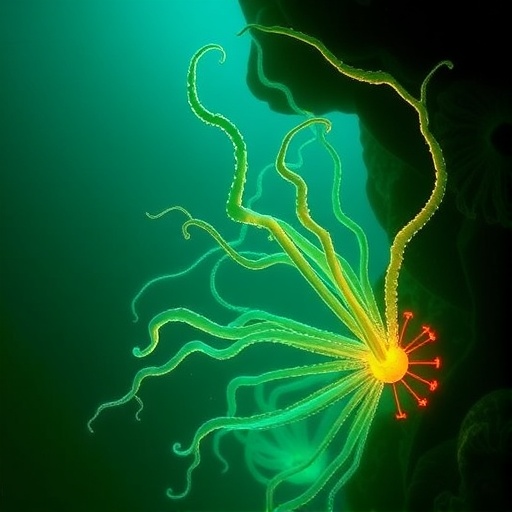In a groundbreaking advancement that challenges existing paradigms of microbial photobiology, researchers have unveiled novel structural insights into how marine Asgard archaea harness light energy. The study, led by Tzlil, Marín, Matsuzaki, and colleagues and published in Nature Microbiology (2025), sheds light on the remarkable capabilities of rhodopsins outfitted with antenna complexes—an unexpected trait in these enigmatic microorganisms that further blurs the boundaries between prokaryotic and eukaryotic life.
Asgard archaea, a recently discovered superphylum residing predominantly in marine sediments, have captivated scientists for their pivotal evolutionary role as likely ancestors to eukaryotes. Yet, the revelation that some Asgard species employ light-harvesting rhodopsins equipped with elaborate antenna systems expands their biological repertoire in ways previously unimagined. Unlike canonical rhodopsins which typically act as singular photoreceptive units, the antenna-containing variants described in this study concertedly capture and funnel photons, boosting energetic efficiency in their dimly lit ecological niches.
The research team employed a sophisticated combination of cryo-electron microscopy (cryo-EM), X-ray crystallography, and state-of-the-art computational modeling to resolve the three-dimensional architecture of these antenna complexes at near-atomic resolution. Their findings unveiled a modular assembly where the rhodopsin proteins integrate with carotenoid and chlorophyll-like pigments arranged spatially to optimize light absorption across a broad spectrum. This strategic pigment arrangement mimics, yet distinctively diverges from, classical bacterial photosystems known to date.
Integral to this newly discovered light-harvesting mechanism is the synergy between the retinal chromophore within the rhodopsin and the surrounding pigment molecules. The researchers decoded the precise energy transfer pathways, demonstrating quantum efficiency in photon capture surpassing many known prokaryotic systems. This research not only offers a window into the biochemical sophistication of Asgard archaea but also advances our understanding of how primitive life forms might have exploited photonic energy to thrive in challenging marine environments.
The evolutionary implications are just as profound. The presence of antenna-bound rhodopsins in these archaea suggests that the early evolutionary landscape was more complex and photoactive than previously believed. It prompts a reassessment of energy capture strategies employed by the last universal common ancestor (LUCA) or closely related progenitors, hinting that light-based bioenergetics could have played a formative role in shaping cellular complexity.
Moreover, the structural intricacies uncovered also raise fascinating questions about the genetic origins and horizontal gene transfer events that might have facilitated the acquisition or refinement of these rhodopsin systems. The study’s comparative genomic analyses hint at a mosaic evolutionary origin, with gene clusters showing signatures of lateral transfers from phototrophic bacteria into the Asgard lineage, followed by adaptive divergence to marine sediment conditions.
From a biophysical perspective, the elucidation of energy transfer via Förster resonance energy transfer (FRET) mechanisms within the antenna arrays provides a detailed roadmap for biomimetic applications. The spatial precision and pigment tuning exemplify a natural blueprint for engineering artificial photosystems. These can be harnessed in sustainable energy technologies, particularly in the design of nanoscale photonic materials capable of efficient solar energy capture under low-light conditions.
Additionally, the marine environment from which these Asgard archaea were isolated is characterized by strong gradients of light penetration, where conventional photosynthesis is limited or absent. The rhodopsin-antenna complexes thus enable these organisms to exploit residual light and ambient bioluminescence, painting a picture of previously underestimated ecological niches supported by novel phototrophic mechanisms.
This insight into microbial light-harvesting challenges conventional boundaries defining photosynthesis and photoheterotrophy. While Asgard archaea lack canonical photosystems akin to cyanobacteria or plants, their rhodopsin-based complexes function with unprecedented sophistication, arguably representing a distinct photometabolic strategy that converges toward, yet remains separate from, established autotrophic pathways.
The discovery holds significant promise in illuminating mechanisms of energy harnessing beyond classic photosynthetic paradigms. It encourages re-exploration of microbial diversity in understudied environments for comparable or novel photoreceptive systems. Such exploration could redefine our understanding of the global marine energy cycle, particularly under the context of climate change and ocean deoxygenation altering microbial community compositions.
The intricate molecular details presented also enrich the fundamental biochemistry of microbial rhodopsins, long studied primarily as light-driven ion pumps or sensory proteins. The antenna association dramatically expands their functional repertoire, potentially offering avenues for synthetic biology to engineer multifunctional photoreceptors for optogenetics or biotechnological applications requiring tailored light capture and signal transduction.
Synchronic advances in cryo-EM resolution and pigment spectroscopy have enabled this exceptional structural clarity. The authors combined high-resolution maps with ultrafast spectroscopy to characterize energy transfer kinetics, revealing a finely tuned balance between pigment absorption spectra and rhodopsin conformational dynamics. Such synergy underscores the evolutionary ingenuity in assembling these complexes, which maximize solar energy utility while maintaining stability under fluctuating marine conditions.
Importantly, these findings stimulate fresh dialogue on the metabolic versatility of Asgard archaea. Beyond their well-documented role in archaeal-eukaryotic evolution, their phototrophic capabilities introduce potential contributions to biogeochemical cycles, including carbon fixation, redox transformations, and nutrient mobilization governed partly by light availability.
The study’s extensive data repositories and models provide a robust foundation for future experimental interrogations, including genetic manipulation of Asgard systems or heterologous expression of antenna rhodopsin complexes. These efforts could unravel regulatory networks controlling light harvesting and integrate findings with ecological observations to map phototrophic behavior in situ.
In summary, this compelling investigation redefines Asgard archaea not merely as evolutionary curiosities but as pioneers of complex light-harvesting strategies. The discovery that they harbor antenna-containing rhodopsins refines our grasp of microbial photobiology, evolution, and ecological adaptation. It opens exciting avenues for sustainable innovation grounded in nature’s own refined mechanisms for capturing and utilizing the sun’s energy.
Subject of Research: Structural and functional characterization of antenna-containing rhodopsins in marine Asgard archaea and their role in light harvesting.
Article Title: Structural insights into light harvesting by antenna-containing rhodopsins in marine Asgard archaea.
Article References:
Tzlil, G., Marín, M.d.C., Matsuzaki, Y. et al. Structural insights into light harvesting by antenna-containing rhodopsins in marine Asgard archaea. Nat Microbiol (2025). https://doi.org/10.1038/s41564-025-02016-5
Image Credits: AI Generated




